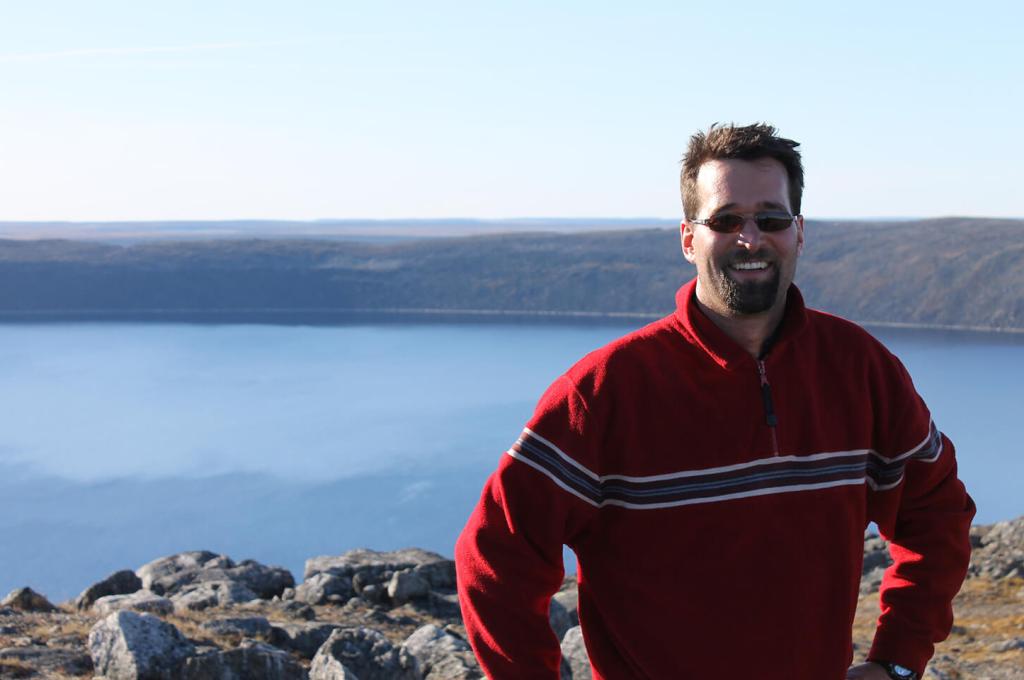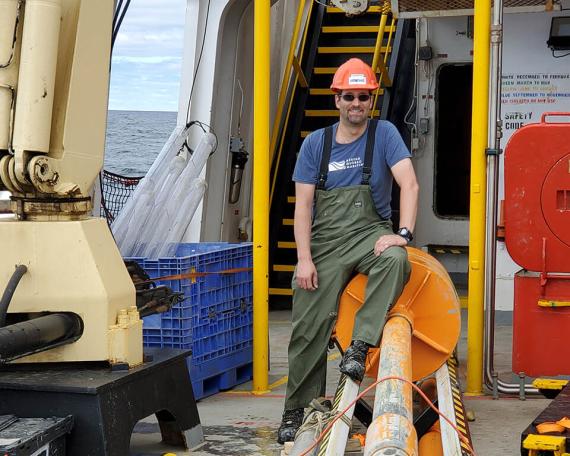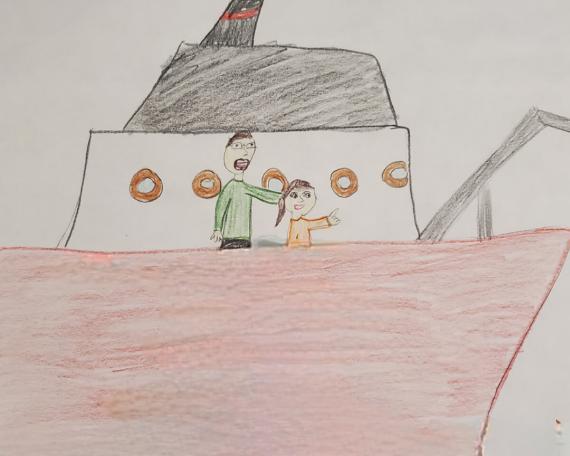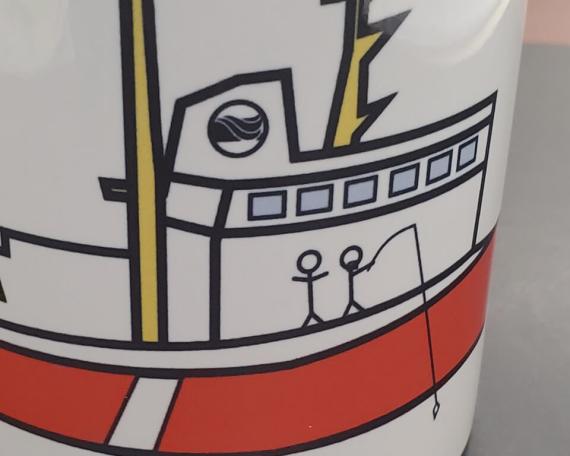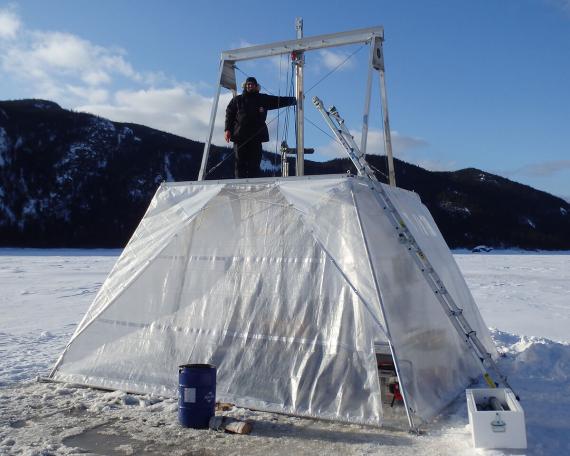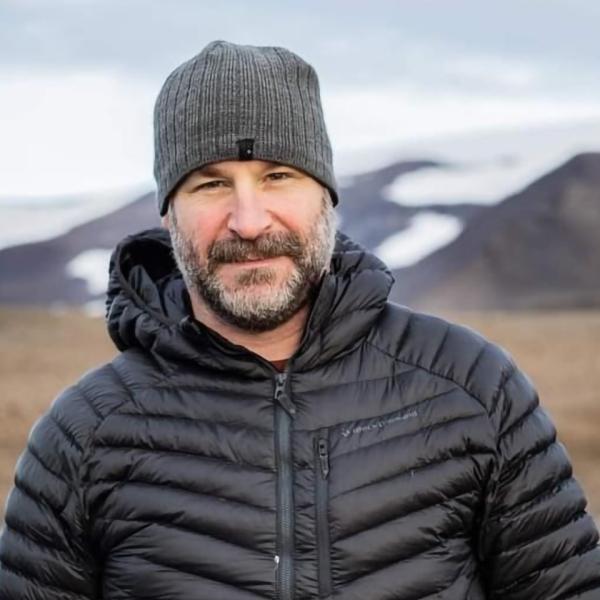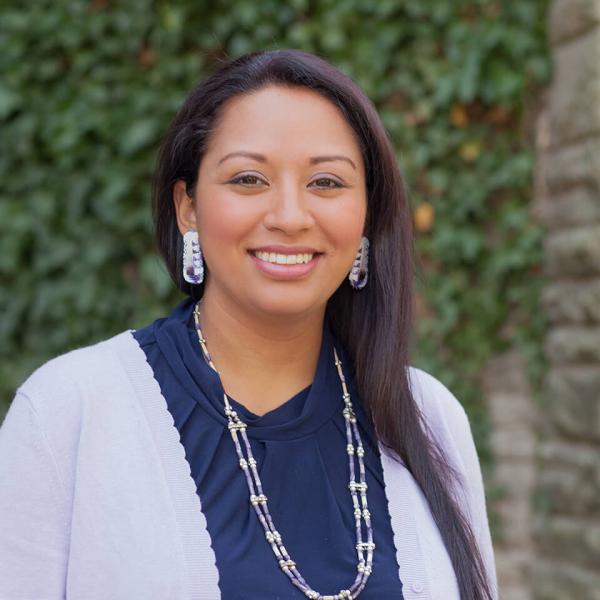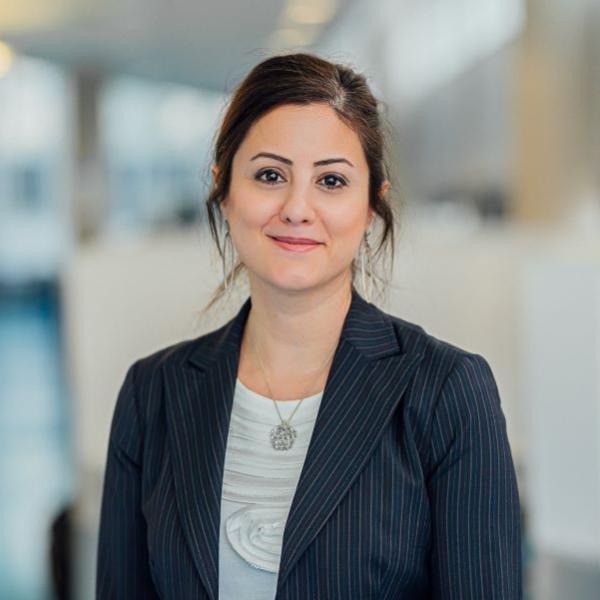HOST
This is a Canada Foundation for Innovation podcast.
(Music in)
Hello and welcome to 10,000 ways. This is a podcast about curious researchers, leading-edge science and the joys of discovery.
Our podcast gets its name from Thomas Edison who said, “I have not failed. I’ve successfully found 10,000 ways that will not work.”
(Music out)
Some 15 billion years ago, there was the Big Bang.
Then, the Earth formed about 4.6 billion years ago.
1.5 billion years after that, the Earth was completely covered in water.
Today, 71 percent of our planet’s surface is covered in water.
It’s no surprise then that humankind is fascinated by and drawn to the deepest depths of the ocean floor.
Remember Jules Verne’s 1870 book Twenty Thousand Leagues Under the Sea?
Captain Nemo tells Professor Aronnax that
(Sound effect starts)
“The sea is everything … The sea is only the embodiment of a supernatural and wonderful existence.”
(Sound effect ends)
So why not explore this supernatural and wonderful existence, and look deep into the sea floor?
(Music in)
GUILLAUME ST-ONGE
My name is Guillaume St-Onge. I am the Director of the Institut des sciences de la mer de Rimouski (ISMER) and I am a Canada Research Chair in Marine Geology.
ISMER is the only institute at Université du Québec à Rimouski and conducts very high-level research in four major fields of marine science: marine geology, physical oceanography, marine biology and marine chemistry.
I’m interested in seabeds: everything that seabeds are made of and everything that you find in seabeds. It doesn’t matter where — the estuary and the Gulf of St. Lawrence, the Saguenay Fjord, the Canadian Arctic, the Antarctic, the southern hemisphere in Patagonia and New Zealand, Tibet, Europe — I’m interested in it all.
One of the perks of marine geology is that I get to travel around and explore our planet. There’s something magical about exploring. It keeps us dreaming and those dreams push us to go above and beyond.
(Music out)
HOST
I’m dreaming about all that travel! So many far-flung places!
Nothing happens by accident, but did Guillaume ever think this would be his life?
(Music in)
GUILLAUME ST-ONGE
I actually always wanted to be an astronaut and explore new worlds. I’ve always thought that exploration brought out the best in humanity. Exploration allows countries to work together and that’s what I really had hoped to do. I even started the process to become an astronaut, but unfortunately, it didn’t work out. It’s very competitive.
Still, I became an explorer. I think I have the best job in the world because we get to use research vessels to roam the world, explore the seabed, and make discoveries and major breakthroughs along the way.
(Music out)
HOST
That goes to show that taking a different path isn’t the same as going off course.
Guillaume now leads many successful land and ocean expeditions.
One of those expeditions gave him a feeling not unfamiliar to astronauts in space — a feeling of absolute silence and emptiness, but also absolute bliss!
GUILLAUME ST-ONGE
For one of my expeditions, I went to the Pingualuit Crater in northern Quebec, a meteorite crater with some of the most pristine water in the world. It was one of the hardest, most physically challenging trips I’ve ever been on because we had to protect the local environment. That meant no snowmobiles on the lake, no gas and no dog sleds. But when we finally reached the top of the crater and saw the lake for the first time, it took my breath away.
The lake was stunningly beautiful, mystical even. The place felt magical. And to my surprise, in that moment, it was completely silent. I’ll remember that moment for the rest of my life because it was so special, that complete silence. No sounds, no noise, just total silence in the Arctic, gazing upon the lake in all its majesty.
HOST
Some days, Guillaume is left speechless by his work.
Other days are a little funnier…
Imagine his children’s elementary school teachers asking, “And what does your dad do for work?”
(Music in)
GUILLAUME ST-ONGE
It was pretty funny — my children told their teachers that I went to sea and gathered carrots. It’s safe to say my children’s teachers were a little confused about what I do for work.
They thought I was a farmer, who for some reason went to sea. They had no idea what I did until I came to talk to the class one day. I explained my job and showed the class real sediment cores (“carottes sédimentaires” in French). The students were able to touch the sediment cores to better understand what exactly sediments are.
So part of my work is going to sea and harvesting “carrots.” But then we take those sedimentary cores back to the lab to run tests on each and every centimetre.
(Music out and in again)
I’ve been on trips for international projects where the core was a kilometre long and dated back millions of years. By going that far back in time, we can really put things in perspective.
(Sound effect: pages of a book being flipped)
Sedimentary cores tell stories, just like a book does, but their stories are about the climate, the natural climate variations over time, natural hazards, extreme events. This data is essential to properly modelling the future.
(Music out)
HOST
All aboard! Time to find out what happens on the research vessel!
GUILLAUME ST-ONGE
When we send a corer into water that’s several kilometres deep, it takes several hours. If we realize it didn’t work, we have to do it all over again. It’s a job that requires a lot of patience — there’s always a chance we’ll need a do-over. So we stick with it, send the corer out again and typically it works the second time. Every once in awhile, our probes will show that the sediment is ideal for coring, but the corer hits a big rock on the seabed that our probes missed. That’s just bad luck. Other times, we have great luck, and our probes help us make amazing discoveries. That’s one of the things I love about my job. As we explore, we discover new things, and sometimes those discoveries happen immediately. It’s incredible to get to share those “Eureka!” moments with my students and colleagues.
HOST
Pull a carrot out of your garden and it’s maybe 20 centimetres long, but how long is a sedimentary core pulled out of the ocean floor?
(Music in)
GUILLAUME ST-ONGE
The core arrives in one piece, and the length of the core obviously depends on the vessel. I have some favourite vessels, and one of those is the JOIDES Resolution, which I was on for an expedition to the Gulf of Alaska. It’s an American research vessel that can drill kilometre-long core samples. The vessel will stay in a region for about two months, changing sites from time to time and drilling very, very long core samples.
My second favourite is the Marion Dufresne, a French research vessel that can drill 60‑metre‑long samples. The Coriolis II is another incredible vessel that is 50 metres long and actually funded by the CFI.
If you drill a nine-metre-long core sample, you can’t carry it around the deck of the boat, so it gets cut into 1.5 metre sections that can be picked up, transported and then analyzed in the lab.
(Music out)
HOST
Do you think that the lab is less busy and hectic than the deck?
GUILLAUME ST-ONGE
Samples are kept in a cold room. At ISMER, I’m lucky enough to have a minimum of two walk-in cold rooms, often referred to as “carothèques.” Samples are kept at four degrees Celsius to keep bacterial growth at bay for many years.
(Music in)
In the lab, we typically take our core samples and examine them with different instruments. First, we use a digital X-ray to take a good look at the sedimentary structures within the cores and quickly identify areas of interest for closer analysis. Then, we pass our samples through an instrument called a Multi-Sensor Core Logger, which measures magnetic susceptibility, sediment density, and electrical resistivity, while quantitatively determining colour with a spectrometer.
(Music out)
So once that’s all done, we cut the core in half with a saw to create a working half and an archive half.
We take samples from the working section to measure grain size and conduct geochemical analyses of …
(Sound effect starts: electronic music)
…carbon, nitrogen, etc. To do so, we use radiogenic isotopes like lead-210 or cesium‑137, which allow us to go back maybe 150 or 200 years.
Then, to date back further, we use carbon-14, which lets us go back around 40,000 to 50,000 years. If we want to date back even further, we’ll turn to paleomagnetism.
For that, I have an instrument called a cryogenic magnetometer that lets us measure magnetic fluctuations in the sediment.
That’s how I piece together the fluctuations of the Earth’s magnetic field over time for all sorts of reasons. The first is fundamental — to understand how the Earth’s magnetic field works. The second is stratigraphic. The Earth’s magnetic field reverses from time to time. So, the north pole goes to the south pole and the south pole goes to the north pole.
Sometimes, the poles will start to reverse, but not actually fully reverse. This is called a geomagnetic excursion. We can use these events to very precisely date the sediment.
(Sound effect ends)
So that’s the stratigraphic side of my work. The data we gather centimetre by centimetre on magnetic properties lets us develop environmental and climate change tracers over time.
It takes several days to fully analyze a 1.5-metre-long section.
As for the archive section, we preserve it intact as long as possible so we can collaborate with researchers around the world who may be interested in working on any given core.
HOST
Cold rooms and cryogenic magnetometers! That’s one state-of-the-art laboratory!
GUILLAUME ST-ONGE
I’m so, so proud to have put together this incredible lab. It’s one of the best-equipped labs in the world for the work that I do analyzing the physical and magnetic properties of sediment. It’s obviously in large part thanks to the CFI — I think I’ve received four CFI awards for my own research.
There’s also the CFI funding my colleagues received for the Coriolis before I became a professor, which is what made it possible for us to use such a major research vessel. I am very proud to have built this group at ISMER.
Recently, I’ve been getting involved in leading and coordinating marine science research in Quebec, and that’s been going well.
We’ve created the Réseau Québec maritime and the Institut France-Québec maritime, which are networks that work towards sustainable development with all different maritime sector stakeholders including companies, universities, colleges, college centres for the transfer of technologies, provincial and federal departments, and other partners like First Nations and coastal communities.
This has really helped get the ball rolling for marine science in Quebec and across Canada.
HOST
It’s said that in adversity, we know our friends.
Guillaume’s success in uniting marine science researchers the world over just goes to show that our planet is facing some real threats.
Can their research make a difference?
(Music in)
GUILLAUME ST-ONGE
We have to understand all of the mechanisms responsible for climate change and glacier ice‑ocean interactions, so we try to find clues that let us piece together the natural variability of the climate or the natural hazards it has seen — it’s the same thing.
If we take a look at earthquakes, hurricanes and floods, there’s a clear increase in frequency. The idea, then, is to understand the frequency of major, potentially devastating earthquakes so we can better protect our infrastructure. That serves as the basis for establishing a building code for designing buildings that can withstand earthquakes, and to do that, we need to know the seismic hazard.
To derive the seismic hazard, we need to know the frequency going back further than just the historical archives. That’s where the sediment cores come in. Ideally, buildings everywhere would be designed to withstand high-magnitude earthquakes, but that’s just not possible, financially speaking. So, the idea is to create a data-driven building code that shows which regions need less structural security or reliability compared to higher-risk regions.
(Music out)
HOST
In Quebec alone, there are three major seismic zones:
- The Charlevoix-Kamouraska region, where quakes typically occur under the St. Lawrence River
- Western Quebec, which includes Gatineau and Montréal
- And the Bas-Saint-Laurent
Several hundred earthquakes occur in Quebec each year.
That makes knowing the seismic hazard and acting accordingly extremely important.
But Guillaume stresses that there is one critical thing that his research depends on above all else.
(Music in)
GUILLAUME ST-ONGE
I’d like to see Canada develop a fleet of research vessels and become a global leader in oceanography, marine science and the blue economy.
We have no other choice. We need icebreakers, research vessels and staff, all of which is quite difficult to get funding for in our current system. To give you an idea, there are no other research vessels in Canada besides the Coriolis, which is a 50-metre boat at UQAR that can go into the estuary and the Gulf of St. Lawrence, maybe also out to the open sea. There had previously been a larger boat, the Hudson, but it’s been decommissioned.
That means there’s no longer a large-scale vessel for big teams and big projects. We do have one icebreaker, but it belongs to the coast guard, which needs it for its icebreaking work. We need to maintain our infrastructure, and that’s the challenge.
Otherwise, we rely a lot on our international colleagues, like the Americans or the Germans, but that has drawbacks. Often, we don’t get to choose the sites we visit. We’re basically just piggybacking off them. Our German and French and American colleagues are very nice about it, but we have less power to decide where we want to go. We’re also less able to train the next generation of scientific leaders — that takes resources.
(Music out)
HOST
If that’s not convincing enough, Guillaume has another reason why we should invest in scientific research — and to come full circle, let’s revisit space exploration.
(Music in)
GUILLAUME ST-ONGE
Going back to space exploration, yes, it’s exorbitantly expensive, but it’s also inspiring. It inspires humanity to push past its limits, go above and beyond and find solutions. There’s nothing quite like space exploration to inspire folks. For me, what’s most important is to inspire the people around the world. That’s what drives me — the opportunity to make a difference. I know that the work we’re doing, and especially the work that’s been done globally in recent years, can help us make a difference for the planet.
You can’t put a price on it — sending a Canadian astronaut to space could inspire more young folks to go to space and find new solutions. That’s why inspiration is so important to me.
(Music out)
HOST
(Music in)
Where does inspiration come from?
Who inspired Jules Verne?
Who has Jules Verne inspired?
Which classmates of Guillaume’s children will go on to study oceanography?
Will you pay closer attention in the future to news about the Coriolis II and Canada’s fleet of research vessels?
(Music out and in again)
Jack London once said, “You can’t wait for inspiration. You have to go after it.”
So don’t wait!
(sound effect: siren)
Take a page out of Guillaume St-Onge’s book, lace up your sneakers and run out there to find whatever sparks your inspiration!
***
10,000 ways is produced by the Canada Foundation for Innovation (CFI).
The CFI is a non-profit corporation that funds Canadian universities, colleges, research hospitals and non-profit research institutions to help them invest in research infrastructure.
Since its inception in 1997, the CFI has invested nearly $10 billion into more than 12,000 projects across all sectors.
If you’re curious to learn more about the CFI, then please visit Innovation.ca.
My name is Émilie Delattre, and if you liked what you heard, be sure to tune in to our next episodes hosted on Blubrry, Apple podcasts, Android, Google Podcasts and the CFI’s RSS feed.
Thank you for listening. See you soon!
(Music out)


